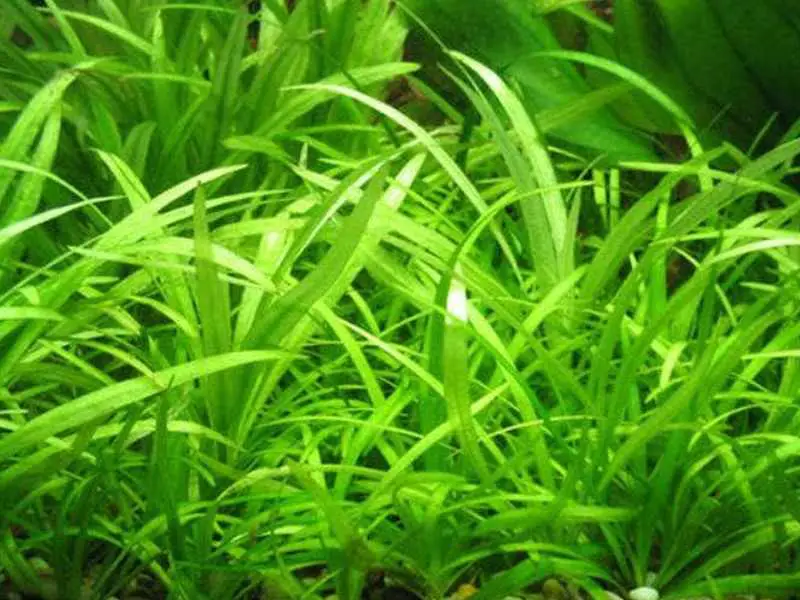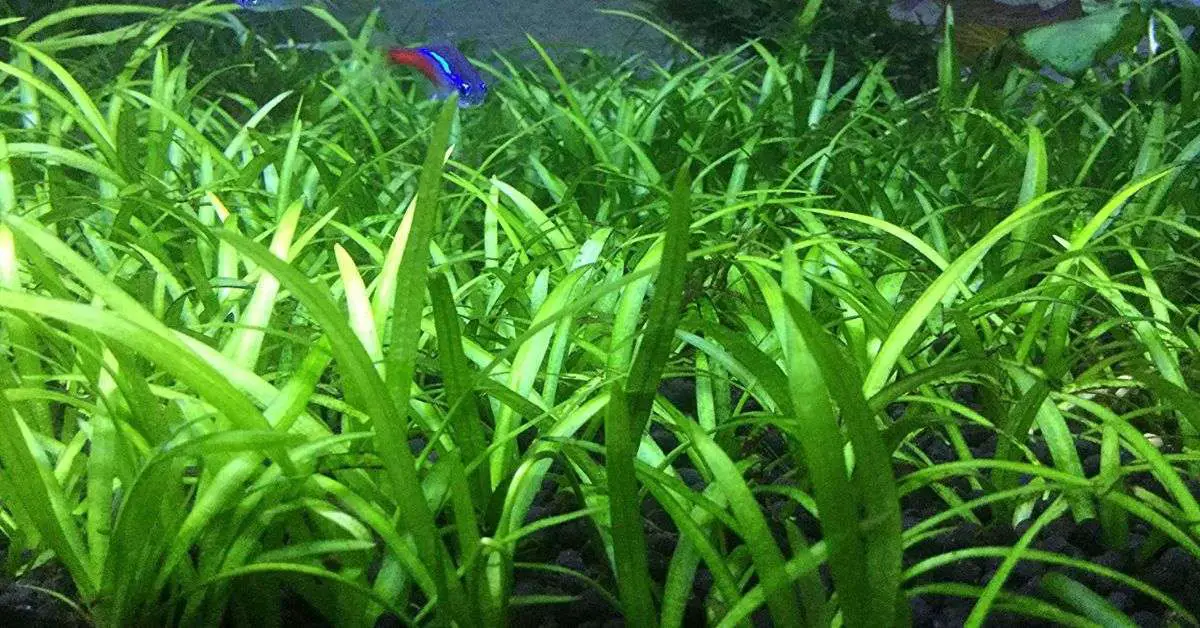The Narrow Leaf Chain Sword-Echinodorus tennelus is a popular aquarium plant that can be found in many pet stores. It is also known as Pygmy Chain Sword, Dwarf Amazon sword, Micro Sword, etc.
This plant is easy to care for and grows quickly, making it a great choice for beginner aquarists. It thrives in both fresh and salt water, making it a versatile choice for aquarists. In this blog post, we’ll give you some tips on how to take care of your narrow leaf chain sword plant so that it stays healthy and thrives.
Habitat
Narrow leaf chain sword is a beautiful aquarium plant that is native to North and South America but can be found in many other parts of the world as an introduced species. It prefers to live in ponds, streams, marshes and other water bodies. They can grow partially or fully submerged conditions.
Physical Appearance
The leaves are long and slender with a chain-like pattern along the edge. This gives the plant its common name. Narrow Leaf Chain Sword grows quickly and can reach up to 24 inches (60 cm) in height. It does best when it is planted in groups or colonies, so it is often used as a background plant in aquariums. It produces small white flowers on long stems and can reach up to 18 inches tall.

Housing and Care Facts
The Narrow Leaf Chain Sword is a hardy plant that does well in most water conditions. It prefers moderate to bright lighting conditions and CO2 levels and can tolerate temperatures from 72 to 80° F (22 – 26 °C). The plant will grow best if you fertilize it regularly with an all-purpose liquid fertilizer. It does best when you offer nutrient-rich soil and water regularly.
The Narrow Leaf Chain Sword is an attractive addition to any aquarium and makes a great focal point or background plant. It is ideal for planted tanks of 20 gallons or more but can also be used in smaller tanks if space allows.
Tankmates
Narrow Leaf Chain Sword (Echinodorus tenellus) is a great plant for any beginner looking to start up a planted tank. This low-maintenance plant can be easily grown in most aquariums and it can tolerate a wide range of water conditions. It makes an excellent addition to any community tank, and can be paired with other easy-to-care for plants like Anubias or Java Fern.
As far as fish companions go, Narrow Leaf Chain Sword can do well with most peaceful fish species. However, avoid keeping it with overly aggressive or territorial fish, as they may eat the leaves of this delicate plant. Some good choices for tankmates include: guppies, platys, tetras, barbs, cory catfish and loaches.
Benefits of a Healthy Narrow Leaf Chain Sword Plant
A healthy Narrow leaf Chain Sword plant has many benefits, including: they improve air quality, increase humidity, and do purification of water. Additionally, these plants are low-maintenance and easy to care for.
How to Fertilize Your Chain Sword Plant
Fertilize your Chain Sword plant every other month using a balanced fertilizer diluted to half strength. Be sure not to over fertilize as this can burn the roots of the plant.
How to Prune Your Chain Sword Plant
Pruning is important to encourage new growth and keep your plant looking its best. To prune, simply cut back the stems to the desired length using sharp scissors or pruning shears.
Benefits of Proper Lighting For Your Chain Sword Plant
Chain Sword plants are native to the tropics, so they thrive in bright, indirect sunlight. If you live in a colder climate, you can provide your Chain Sword plant with artificial light to help it grow.
Proper lighting is important for several reasons:
• It helps the plant produce food through photosynthesis.
• It prevents the plant from getting leggy or etiolated.
• It keeps the leaves healthy and vibrant.
How to Choose the Right Location For Your Chain Sword Plant
When choosing a location for your Chain Sword plant, make sure it is in a spot that gets plenty of bright, indirect light. In this case, south- or west-facing windows are ideal. If you don’t have a spot like that in your home, you can use artificial lighting to provide the right amount of light for your plant.
Be sure to avoid locations that are too hot or too cold, as extreme temperatures can damage the leaves of your Chain Sword plant. Also avoid locations where there is drafts or direct sunlight, as both can also damage the leaves.
How to provide the right amount of light for your Chain Sword plant
If you are using artificial lighting to provide light for your Chain Sword plant, be sure to use a fluorescent bulb that emits full-spectrum light. Place the light about 12 inches (30 cm) from the plant and leave it on for 14-16 hours per day.
Propagation of Chain Sword Plant
If you want more plants, the best way to get them is by propagating your existing plant. Not only is it free, but it is also really easy to do. Plus, it is a great way to ensure that your new plants are genetically identical to the parent plant.
There are two main ways to propagate a Chain Sword plant: by division or by stem cuttings. Division is the quickest and easiest method, while stem cuttings will produce a higher percentage of rooted plants.
Propagation of Chain Sword Plant by Division
To propagate your plant by division, simply remove the plant from its pot and gently pull it apart into two or more sections, making sure each section has at least one set of leaves. Plant each section in its own pot filled with fresh potting mix, and water well.
Propagation of Chain Sword Plant by Stem Cuttings
To propagate your plant by stem cuttings, first fill a small pot with fresh potting mix and moisten it well. Next, take a 4-6 inch cutting from the tips of healthy stems, making sure each cutting has at least two sets of leaves. Remove the bottom set of leaves from each cutting, dip the cut end in rooting hormone (optional), and then insert the cutting into the prepared potting mix. Water well and place the pot in a warm, bright location out of direct sunlight. Keep the soil moist but not soggy until new growth appears.
Suitable Time For Propagation of Your Chain Sword Plant
The best time to propagate your ChainSword plant is in late spring or early summer, when the weather is warm and the days are long. However, you can also propagate your plant at other times of the year if necessary.
Common problems with Chain Sword plants
Brown leaves: If the leaves of your Chain Sword plant start to turn brown, it could be due to a number of reasons. It could be that the plant is getting too much sun, or not enough water. If you think that the plant is not getting enough water, try increasing the amount you water it each week. If you think that the plant is getting too much sun, try moving it to a location with indirect light.
Yellow leaves: Yellow leaves on a Chain Sword plant can indicate that the plant is not getting enough light. Try moving the plant to a location with more light, and make sure to provide at least six hours of direct sunlight each day. If the problem persists, consider using artificial lighting to supplement the natural light.
Drooping leaves: Drooping leaves can be a sign that your Chain Sword plant is not getting enough water. Try increasing the amount you water it each week, and make sure that the soil is evenly moistened but not soggy. If the problem persists, check to see if the roots are crowded and consider repotting your plant in fresh soil.
Leggy growth: Leggy growth can be caused by several factors, including lack of light and over-fertilization. To fix this problem, try moving your Chain Sword plant to a location with more light and pruning back any leggy growth. You may also need to adjust your fertilizing schedule and use a fertilizer with lower nitrogen levels.
Tips for caring for your Chain Sword plant
Be patient: The Chain Sword plant is a slow-growing plant, so be patient when caring for it. It can take several months for the plant to reach its full size.
Don’t over fertilize: Fertilize your Chain Sword plant only once a month with a balanced fertilizer. Over fertilizing can burn the roots and leaves of the plant.
Prune regularly: Prune your Chain Sword plant every two to three weeks to encourage new growth. Regular pruning will also help keep the plant from getting too leggy.
Give it plenty of light: Place your Chain Sword plant in an area that gets direct sunlight for at least six hours a day. The more light the plant gets, the healthier it will be.
The Narrow leaf Chain Sword is a beautiful and easy to care for aquarium plant. Here are some more tips to help you keep your plant healthy and thriving:
The Narrow leaf Chain Sword prefers moderate to bright light levels and should be placed in an area of the aquarium that receives indirect sunlight. Too much light can cause the leaves to turn yellow or brown. If the light is too low, the leaves will turn yellow.
The plant does best when planted in a substrate that is rich in nutrients. Be sure to use a good quality fertilizer regularly to ensure your plant has all the nutrients it needs. In this case, you can use liquid plant food supplement designed for aquatic plants. A balanced diet will help keep your Narrow leaf Chain Sword healthy and looking its best.
To keep your Narrow leaf Chain Sword looking its best, periodically trim off any dead or dying leaves using sharp scissors.
Make sure the water in your aquarium is clean and has the correct pH level.
Give your Narrow leaf Chain Sword plenty of light. It thrives in bright, sunny conditions and will grow best if you give at least six hours of direct sunlight each day.
The water temperature should be kept between 72 and 80 degrees Fahrenheit (°F) (22 – 26 ° C).
Aquariums with high levels of dissolved organic material (such as those with lots of live plants) may not be suitable for this plant, as it can cause brown patches on the leaves. In these cases, you may need to use a filter or regularly change the water to keep the levels down.
Finally, ensure that the water in your tank is clean and well-oxygenated by changing it regularly and adding an air pump or bubbler.
With these simple tips, you can enjoy watching your beautiful Narrow leaf Chain Sword thrive in its new home.
Concluding Remarks
If you follow these simple tips, you will be well on your way to having a healthy and thriving Narrow leaf Chain Sword plant. With a little patience and care, you can enjoy the many benefits that come with owning this unique and beautiful plant.

